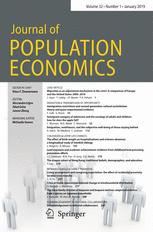The discussion paper of the month explores the vote on the Swiss minaret initiative in 2009 as a natural experiment to identify the effect of newly revealed reservations towards immigrants on their location choices. The research finds that the probability of immigrants to relocate to a municipality that unexpectedly revealed stronger negative attitudes towards them is significantly reduced in the time after the vote. The effect seems to apply to all immigrant groups – Muslim, non-European and European -, and to be stronger for high-skilled immigrants.
GLO Discussion Papers are research and policy papers of the GLO Network which are widely circulated to encourage discussion. Provided in cooperation with EconStor, a service of the ZBW – Leibniz Information Centre for Economics, GLO Discussion Papers are among others listed in RePEc (see IDEAS, EconPapers). Complete list of all GLO DPs downloadable for free.
GLO Discussion Paper of the Month: January
305 The Deterrent Effect of an Anti-Minaret Vote on Foreigners’ Location Choices – Download PDF
by Slotwinski, Michaela & Stutzer, Alois
GLO Fellow Michaela Slotwinski
Abstract: In a national ballot in 2009, Swiss citizens surprisingly approved an amendment to the Swiss constitution to ban the further construction of minarets. The ballot outcome manifested reservations and anti-immigrant attitudes in regions of Switzerland which had previously been hidden. We exploit this fact as a natural experiment to identify the causal effect of negative attitudes towards immigrants on foreigners’ location choices and thus indirectly on their utility. Based on a regression discontinuity design with unknown discontinuity points and administrative data on the population of foreigners, we find that the probability of their moving to a municipality which unexpectedly expressed stronger reservations decreases initially by about 40 percent. The effect is accompanied by a drop of housing prices in these municipalities and levels off over a period of about 5 months. Moreover, foreigners in high-skill occupations react relatively more strongly highlighting a tension when countries try to attract well-educated professionals from abroad.
GLO Discussion Papers of January 2019
308 Technological Unemployment Revisited: Automation in a Search and Matching Framework – Download PDF
by Cords, Dario & Prettner, Klaus
307 Gender, culture and STEM: Counter-intuitive patterns in Arab society– Download PDF
by Friedman-Sokuler, Naomi & Justman, Moshe
306 Time preferences and political regimes: Evidence from reunified Germany– Download PDF
by Friehe, Tim & Pannenberg, Markus
305 The Deterrent Effect of an Anti-Minaret Vote on Foreigners’ Location Choices – Download PDF
by Slotwinski, Michaela & Stutzer, Alois
304 Tropical Storms and Mortality under Climate Change – Download PDF
by Pugatch, Todd
303 The Post-Crisis Phillips Curve: A New Empirical Relationship between Wage and Inflation – Download PDF
by Voinea, Liviu
302 Marshallian vs Jacobs effects: which one is stronger? Evidence for Russia unemployment dynamics – Download PDF
by Demidova, Olga & Kolyagina, Alena & Pastore, Francesco
301 The World at the Crossroad. Demographic Polarization and Mass Migration. Global threat or global opportunity – Download PDF
by Bruni, Michele
300 The Belt and Road Initiative. Demographic trends, labour markets and welfare systems of member countries – Download PDF
by Bruni, Michele
299 The unprotecting effects of employment protection: the impact of the 2001 labor reform in Peru – Download PDF
by Jaramillo, Miguel
298 Measuring the Statistical Capacity of Nations – Download PDF
by Cameron, Grant J. & Dang, Hai-Anh H. & Dinc, Mustafa & Foster, James & Lokshin, Michael M.
297 Inequality and Welfare Dynamics in the Russian Federation during 1994-2015 – Download PDF
by Dang, Hai-Anh H. & Lokshin, Michael M. & Abanokova, Kseniya & Bussolo, Maurizio
296 A Beveridge curve decomposition for Austria: what drives the unemployment rate? – Download PDF
by Christl, Michael
295 Health, Cognition and Work Capacity Beyond the Age of 50 – Download PDF
by Vandenberghe, Vincent
GLO DP Team
Senior Editors: Matloob Piracha (University of Kent) & GLO; Klaus F. Zimmermann (UNU-MERIT, Maastricht University and Bonn University).
Managing Editor: Magdalena Ulceluse, University of Groningen. DP@glabor.org
Ends;




